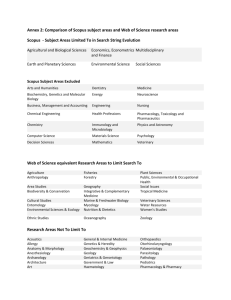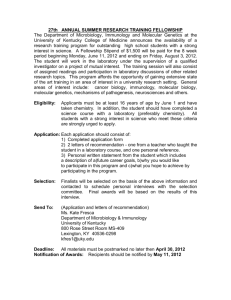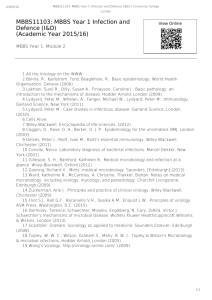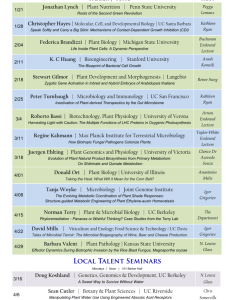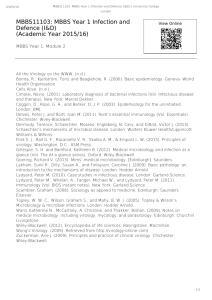Glaunsinger CV - B. Glaunsinger Lab
advertisement
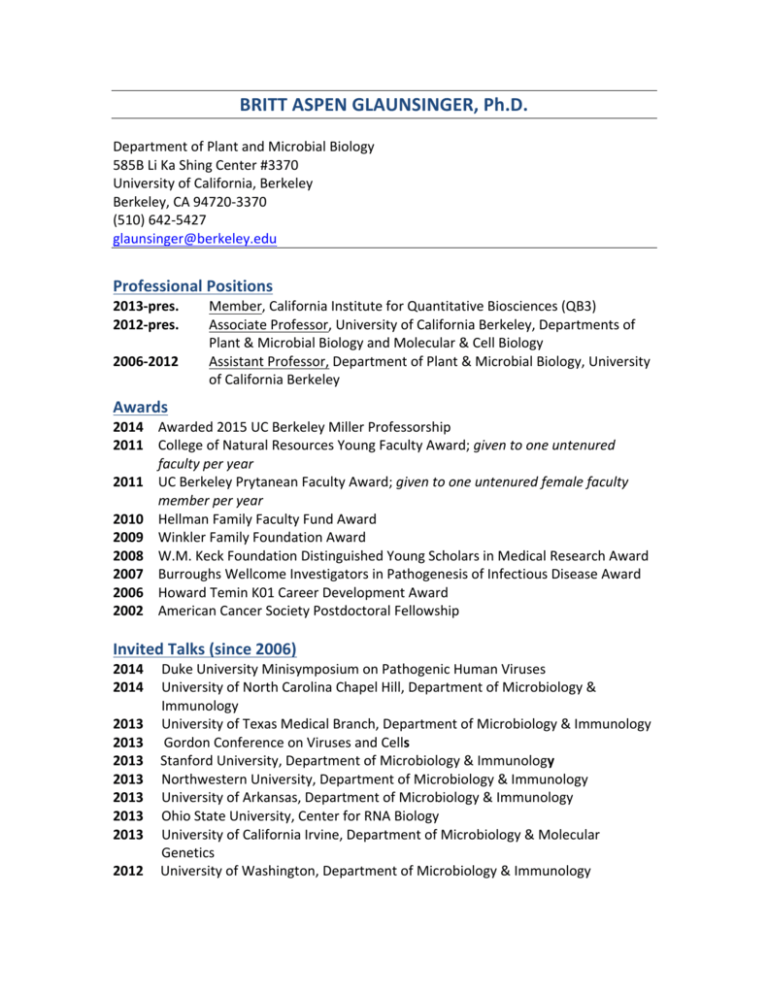
BRITT ASPEN GLAUNSINGER, Ph.D. Department of Plant and Microbial Biology 585B Li Ka Shing Center #3370 University of California, Berkeley Berkeley, CA 94720-­‐3370 (510) 642-­‐5427 glaunsinger@berkeley.edu Professional Positions 2013-­‐pres. 2012-­‐pres. 2006-­‐2012 Member, California Institute for Quantitative Biosciences (QB3) Associate Professor, University of California Berkeley, Departments of Plant & Microbial Biology and Molecular & Cell Biology Assistant Professor, Department of Plant & Microbial Biology, University of California Berkeley Awards 2014 Awarded 2015 UC Berkeley Miller Professorship 2011 College of Natural Resources Young Faculty Award; given to one untenured faculty per year 2011 UC Berkeley Prytanean Faculty Award; given to one untenured female faculty member per year 2010 Hellman Family Faculty Fund Award 2009 Winkler Family Foundation Award 2008 W.M. Keck Foundation Distinguished Young Scholars in Medical Research Award 2007 Burroughs Wellcome Investigators in Pathogenesis of Infectious Disease Award 2006 Howard Temin K01 Career Development Award 2002 American Cancer Society Postdoctoral Fellowship Invited Talks (since 2006) 2014 Duke University Minisymposium on Pathogenic Human Viruses 2014 University of North Carolina Chapel Hill, Department of Microbiology & Immunology 2013 University of Texas Medical Branch, Department of Microbiology & Immunology 2013 Gordon Conference on Viruses and Cells 2013 Stanford University, Department of Microbiology & Immunology 2013 Northwestern University, Department of Microbiology & Immunology 2013 University of Arkansas, Department of Microbiology & Immunology 2013 Ohio State University, Center for RNA Biology 2013 University of California Irvine, Department of Microbiology & Molecular Genetics 2012 University of Washington, Department of Microbiology & Immunology 2012 University of California San Francisco, Department of Microbiology & Immunology 2012 Session Chair, FASEB conference: Posttranscriptional Control of Gene Expression: Effectors of mRNA Decay 2012 Priscilla Schaffer Keynote Lecture, 37th International Herpesvirus Meeting 2012 State of the Art Lecture, American Society for Virology Annual Meeting 2012 Heinrich-­‐Pette Institute, Hamburg, Germany 2012 EMBO/EMBL Symposium: The complex life of mRNA 2011 USDA Plant Gene Expression Center 2011 Bay Area Symposium on Viruses 2011 W.M. Keck Foundation 2010 Invited Talk & Session Chair, American Society for Virology Medical Virology Club 2010 Tufts University Department of Microbiology 2010 Washington University School of Medicine, Department of Molecular Microbiology 2009 Department of Plant & Microbial Biology 20th Anniversary Symposium 2009 University of Pennsylvania Department of Microbiology 2009 University of Texas Austin Department of Molecular Genetics & Microbiology 2009 Invited Talk, W.M. Keck Foundation 2008 Invited Seminar, Molecular, Cellular, and Developmental Biology Graduate Student Symposium, University of Colorado Boulder 2008 University of Texas Southwestern, Infectious Diseases Virology Seminar Series 2007 Keynote Speaker, Baylor College of Medicine Department of Molecular Virology and Microbiology Research Retreat 2006 Keynote Speaker, UC Berkeley Seventh Annual Student Microbiology symposium 2006 Colorado State University Department of Biochemistry and Molecular Biology 2006 University of Colorado Denver Health Sciences Center Program in Molecular Biology 2006 University of California Berkeley Department of Plant and Microbial Biology Peer-­‐Reviewed Publications 1. Karijolich J, Zhao Y, Peterson B, Zhou Q, and Glaunsinger B. (2014) Kaposi’s sarcoma-­‐associated herpesvirus ORF45 mediates transcriptional activation of the HIV-­‐1 LTR via RSK2. Journal of Virology. doi:10.1128/JVI.00931-­‐14 [Apr 09, Epub ahead of print] 2. Kronstad L, Brulois K, Jung JU, and Glaunsinger B. (2014) Reinitiation after Translation of Two Upstream Open Reading Frames Governs Expression of the ORF35-­‐37 KSHV Polycistronic mRNA. Journal of Virology. 88(11):6512-­‐6518. PMCID: in progress. 3. Wong-­‐Ho E, Wu TT, Davis ZH, Zhang B, Huang J, Gong H, Deng H, Liu F, Glaunsinger B, Sun R. (2014) Unconventional Sequence Requirement for Viral Late Gene Core Promoters of Murine Gammaherpesvirus 68. Journal of Virology. Mar;88(6):3411-­‐ 3422. PMCID: in progress. 4. Abernathy E, Clyde K, Yeasmin R, Krug L, Burlingame A, Coscoy L, Glaunsinger B. (2014) Gammaherpesviral gene expression and virion composition are broadly controlled by accelerated mRNA degradation. PLoS Pathogens. Jan;10(1):e1003882. PMCID:PMC3894220 *Recommended as being of "special significance" by Faculty of 1000Prime. http://F1000Prime.com/718248241#eval793491079 5. Hutin S, Lee Y, Glaunsinger BA. (2013) An RNA element in human interleukin 6 confers escape from degradation by the gammaherpesviral SOX protein. Journal of Virology Apr;87(8):4672-­‐4682 6. Kronstad LM, Brulois K, Jung JU and Glaunsinger B. (2013) Dual Short Upstream Open Reading Frames Control Translation of a Herpesviral Polycistronic mRNA. PLoS Pathogens. Jan;9(1):e1003156 PMC3561293 7. Gaglia MM, Covarrubias S, Wong W, Glaunsinger B. (2012) A common strategy for host RNA degradation by divergent viruses. Journal of Virology. Sep;86(17):9527-­‐ 9530. PMCID: PMC3416159 *Selected for Spotlight Feature 8. Kronstad LM, Glaunsinger B. (2012) Diverse virus-­‐host interactions influence RNA-­‐ based regulation during γ-­‐herpesvirus infection. Curr Opin Microbiol. Aug;15(4):506-­‐511. PMCID: PMC3424297 9. Covarrubias S, Gaglia M, Kumar GR, Wong W, Jackson AO, and Glaunsinger B. (2011) Coordinated Destruction of Cellular Messages in Translation Complexes by the Gammaherpesvirus Host Shutoff Factor and the Mammalian Exonuclease Xrn1. PLoS Pathogens Oct;7(10):e1002339. 10. Richner JM, Clyde K, Pedza A, Cheng B, Wang T, Kumar GR, Covarrubias S, Coscoy L, and Glaunsinger B. (2011) Global mRNA Degradation During Lytic Gammaherpesvirus Infection Contributes to Establishment of Viral Latency. PLoS Pathogens. July 7(7): e1002150. 11. Kumar GR, Shum L, and Glaunsinger B. (2011) Importin alpha-­‐Mediated Nuclear Import of Cytoplasmic Poly(A) Binding Protein Occurs as a Direct Consequence of Cytoplasmic mRNA Depletion. Mol. Cell Biol. Aug; 31(15):3113-­‐3125. 12. Clyde K and Glaunsinger B. (2011) Deep sequencing reveals direct targets of gammaherpesvirus-­‐induced mRNA decay and suggests multiple mechanisms govern cellular transcript escape. PLoS ONE. 2011 May 9;6(5):e19655 13. Clyde K and Glaunsinger B. (2010) Getting the Message: Direct Manipulation of Host mRNA Accumulation During Gammaherpesvirus Lytic Infection. Advances in Virus Research. Vol. 78:1-­‐42. *Cover article. 14. Kumar GR and Glaunsinger B. (2010) Nuclear Import of Cytoplasmic Poly(A) Binding Protein Restricts Gene Expression Via Messenger RNA Hyperadenylation and Nuclear Retention of mRNA. Mol. Cell Biol. Nov;30(21):4996-­‐5008. *Selected as recommended paper by Faculty of 1000 Biology http://f1000.com/5725957#eval5708055 15. Gaglia M and Glaunsinger B. (2010) Viruses and the Cellular RNA Decay Machinery. WIRES RNA. 1(1):47-­‐59. 16. Glaunsinger B and Lee Y. (2010) How Tails Define the Ending: Divergent Roles for Polyadenylation in RNA Stability and Gene Expression. RNA Biology. Jan 6; 7(1):13-­‐ 17 17. Covarrubias S, Richner J, Clyde K, Lee Y, and Glaunsinger B. (2009) Host Shutoff is a Conserved Phenotype of Gammaherpesvirus Infection and is Orchestrated Exclusively from the Cytoplasm. Journal of Virology. Sep;83(18):9554-­‐9566 *Selected as ‘must read’ paper by Faculty of 1000 Biology http://www.f1000biology.com/article/id/1164037/evaluation 18. Lee Y and Glaunsinger B. (2009) Aberrant Herpesvirus-­‐Induced Polyadenylation Correlates With Cellular Messenger RNA Destruction. PLoS Biology. May 5;7(5):e1000107. *Highlighted as ‘Editor’s Choice’ article in Science (volume 324, issue 5934 (June 2009); http://www.sciencemag.org/content/vol324/issue5934/twil.dtl) and Nature Reviews Genetics (volume 10, issue 428 (July 2009); http://www.nature.com/nrg/journal/v10/n7/full/nrg2620.html). *Subject of PLoS Biology press release (http://www.eurekalert.org/pub_releases/2009-­‐05/plos-­‐vas052109.php) *Selected as ‘must read’ paper by Faculty of 1000 Biology http://www.f1000biology.com/article/id/1163165/evaluation 19. Rowe M*, Glaunsinger B*, van Leeuwen D*, Zuo J, Sweetman D, Ganem D, Middeldorp J, Wiertz E, and Ressing M. (2007) Host Shutoff during productive Epstein-­‐Barr virus infection is mediated by BGLF5 and may contribute to immune evasion. Proceedings of the National Academy of Sciences. 104(9):3366-­‐3371. *Co first authors. 20. Gregorc U, Ivanova S, Thomas M, Guccione E, Glaunsinger B, Javier R, Turk V, Banks L, Turk B. (2007) Cleavage of MAGI-­‐1, a tight junction PDZ protein, by caspases is an important step for cell-­‐cell detachment and apoptosis. Apoptosis 12(2):343-­‐354 21. Glaunsinger B and Ganem D. (2006) Messenger RNA Turnover and its Regulation in Herpesviral Infection. Advances in Virus Research. 66:337-­‐394. 22. Glaunsinger B, Chavez L, and Ganem D. (2005) The exonuclease and host shutoff functions of the SOX protein of Kaposi’s sarcoma-­‐associated herpesvirus are genetically separable. Journal of Virology. 79(12): 7396-­‐7401 23. Glaunsinger B and Ganem D. (2004) Highly Selective Escape from KSHV-­‐mediated Host mRNA Shutoff and its Implications for Viral Pathogenesis. Journal of Experimental Medicine. 200 (2):391-­‐398 24. Glaunsinger B and Ganem D. (2004) Lytic KSHV Infection Inhibits Host Gene Expression by Accelerating Global mRNA Turnover. Molecular Cell. 13 (5):713-­‐ 723. *Cover article. 25. Frese KK, Lee SS, Thomas DL, Latorre IJ, Weiss RS, Glaunsinger BA, and RT Javier. (2003). Selective PDZ protein-­‐dependent stimulation of phosphatidylinositol 3-­‐ kinase by the adenovirus E4-­‐ORF1 oncoprotein. Oncogene. 22(5):710-­‐721. 26. Glaunsinger BA, Weiss RS, Lee SS, and Javier RT. (2001) Link of the unique oncogenic properties of adenovirus type 9 E4-­‐ORF1 to a select interaction with the candidate tumor suppressor protein ZO-­‐2. EMBO J. 20 (20):5578-­‐5586. 27. Thomas M, Glaunsinger B, Pim D, Javier R, and Banks L. (2001) HPV E6 and MAGUK protein interactions: determination of the molecular basis for specific protein recognition and degradation. Oncogene. 20(39):5431-­‐5439. 28. Glaunsinger BA, Lee SS, Thomas M, Banks L, and Javier R. (2000) Interactions of the PDZ-­‐protein MAGI-­‐1 with adenovirus E4-­‐ORF1 and high-­‐risk papillomavirus E6 oncoproteins. Oncogene. 19(46):5270-­‐5280 29. Lee SS, Glaunsinger B, Mantovani F, Banks L, and Javier R. (2000) Multi-­‐PDZ domain protein MUPP1 is a cellular target for both adenovirus type 9 E4-­‐ORF1 and high-­‐risk papillomavirus type 18 E6 oncoproteins. Journal of Virology. 74(20):9680-­‐ 9693 30. Gardiol D, Kuhne C, Glaunsinger B, Lee SS, Javier R, and Banks L. (1999) Oncogenic human papillomavirus E6 proteins target the discs large tumour suppressor for proteasome-­‐mediated degradation. Oncogene. 18(40):5487-­‐5496 31. Nelson DE, Glaunsinger B, and Bohnert HJ. (1997) Abundant accumulation of the calcium-­‐binding chaperone calreticulin in specific floral tissues of Arabidopsis thaliana. Plant Physiology. 114 (1):29-­‐37

